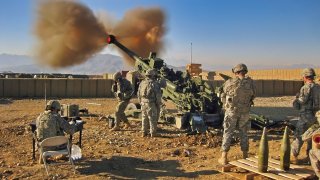Ukraine's M777 Howitzers Face Dire Challenges in the War Against Russia
The M777 is continuing to demonstrate its efficacy in battle in the present day, this time in the hands of the Ukrainian troops fighting against the Russian invaders.
To a casino gambler, three sevens in a row is an extremely lucky jackpot-winning combo on a slot machine. To a savvy air traveler, “triple-7” means the Boeing 777 airliner. But in the military context, more specifically the arena of artillery, the so-called “King of Battle,” “triple-7” has a far more deadly meaning, namely the British-made M777 155mm (6.1 in) howitzer.
M777 Initial History and Specifications
The M777 was designed by the now-defunct Vickers Shipbuilding and Engineering between 1987 and 2003 and officially debuted in 2005 (smack dab in the middle of the Global War on Terror). As per the official info page of its current manufacturer, BAE Systems (headquartered in London):
“Initially developed for the U.S. Marine Corps and the U.S. Army as their next generation Medium Force weapon, the M777 has become the benchmark for 155mm Lightweight Towed Artillery Systems … Highly portable by land, sea and air, the system features a minimal logistical footprint alongside maximum reliability. This means that it can be frequently moved and re-deployed, maximizing survivability, without encountering the IED risks faced by self-propelled systems. The M777 can strike over extended distances, regardless of terrain and obstacles … To date, the M777 howitzer has been selected by U.S., Canadian, Australian, and Indian forces, with total orders currently exceeding 1,200.”
Specifications and vital stats of the M777 include:
·Overall Length: 10.7 meters (35 feet)
·Barrel Length: 5.08 meters (16.7 feet)
·Mass: 4.1 long tons (4.6 short tons)
·Muzzle Velocity: 827 meters per second (2,710 feet per second)
·Effective Firing Range:
o M107 round: 21 kilometers (13 miles)
o M795 round: 23.5 kilometers (14.6 miles)
o M982 Excalibur round: 40 kilometers (25 miles)
Operational History/Combat Performance Part I: Canada and the U.S.
The M777 was first “blooded” in combat by the Royal Canadian Horse Artillery, in support of Operation Archer—the Canadian Forces contribution to Operation Enduring Freedom in Afghanistan—in operations around Kandahar in early 2006. The Canadian-owned M777s proved themselves particularly effective during the Battle of Panjwai, whereupon a mere two of the guns accounted for seventy-two Taliban insurgents killed in action).
The first American troops to use the M777 in combat was the U.S. Army’s 2nd Platoon, Bravo Battery, 2nd Battalion, 11th Field Artillery Regiment (2-FA), doing so in January 2008 in support of Operation Iraqi Freedom (OIF). Fast forward to March 2016 and Operation Inherent Resolve (the fight against the Islamic State terrorist group), and the 26th Marine Expeditionary Unit spent roughly sixty days firing more than 2,000 rounds in 486 fire missions in support of Iraqi Army units engaged in the liberation of Mosul.
Operational History/Combat Performance Part Deux: Ukraine
The M777 is continuing to demonstrate its efficacy in battle in the present day, this time in the hands of the Ukrainian troops fighting against the Russian invaders.
In the wake of Vladimir Putin’s initiation of his “special military operation” in Ukraine in 2022, the United States supplied 142 of these howitzers to the embattled Ukrainian forces. According to my colleague Peter Suciu, “As the conflict turned into a slug match—and earned comparisons to the artillery duels of the First World War—it allowed the Ukrainians the ability to hold their own. While Kyiv’s forces couldn’t maintain the same rate of fire, the M777 had greater range becoming the de facto ‘King’ of the battlefield!”
However, as superbly as the M777s have performed for the Ukrainians, their guns are running afoul of the dual demons of (1) wear and tear and (2) combat losses. Regarding the former malady, the Ukrainian troops have run low on ammunition for the field pieces, and the bores of their guns have literally worn out from the constant barrages. As for the latter, it is estimated that one-third of Ukraine’s “triple-7s” have been destroyed or seriously damaged.
As these words are being written, it is unclear whether or not Ukraine will receive a resupply of M777 guns and/or ammo. Time (and the new incoming U.S. presidential administration) will tell.
About the Author: Christian D. Orr
Christian D. Orr is a Senior Defense Editor for National Security Journal (NSJ). He is a former Air Force Security Forces officer, Federal law enforcement officer, and private military contractor (with assignments worked in Iraq, the United Arab Emirates, Kosovo, Japan, Germany, and the Pentagon). Chris holds a B.A. in International Relations from the University of Southern California (USC) and an M.A. in Intelligence Studies (concentration in Terrorism Studies) from American Military University (AMU). He has also been published in The Daily Torch , The Journal of Intelligence and Cyber Security, and Simple Flying. Last but not least, he is a Companion of the Order of the Naval Order of the United States (NOUS).

